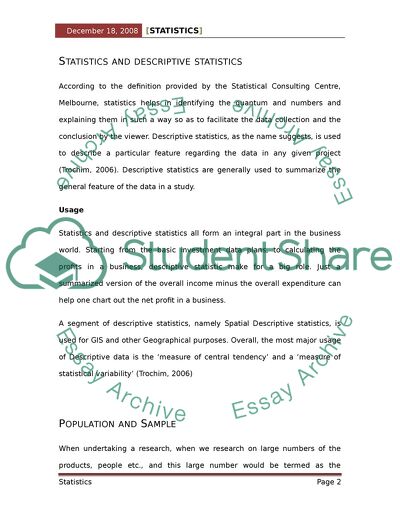
- Home
- Free Samples
- Premium Essays
- Editing Services
- Extra Tools
- Essay Writing Help
- About Us
- Studentshare
- Subjects
- Miscellaneous
- Statistics
Statistics - Essay Example
According to the definition provided by the…

- Subject: Miscellaneous
- Type: Essay
- Level: Ph.D.
- Pages: 4 (1000 words)
- Downloads: 0
- Author: mcclureemmanuel
Extract of sample "Statistics"
Descriptive statistics are generally used to summarize the general feature of the data in a study. Statistics and descriptive statistics all form an integral part in the business world. Starting from the basic investment data plans, to calculating the profits in a business, descriptive statistic make for a big role. Just a summarized version of the overall income minus the overall expenditure can help one chart out the net profit in a business. A segment of descriptive statistics, namely Spatial Descriptive statistics, is used for GIS and other Geographical purposes.
Overall, the most major usage of Descriptive data is the ‘measure of central tendency’ and a ‘measure of statistical variability’ (Trochim, 2006) When undertaking a research, when we research on large numbers of the products, people etc., and this large number would be termed as the ‘population’. Now when the population to be considered and analyzed gets too overwhelming, the researchers attempt to choose various representatives from the population, which are termed as ‘samples’.
(Spiegel, Schiller, & Srinivasan, 2000) (Johnston, 2000) When conducting research for business purposes, especially in terms of identifying marketing strategies, business pockets etc, the use of identifying population and samples can be effectively used. (Spiegel, Schiller, & Srinivasan, 2000) A great example here could be medical / political surveys such as online polls, etc. The question might be “Who do you think will win the 2008 elections?” fields required would be Name, Location, Age.
Here, once the results from all the states have been received (population), we could easily judge the overall view of the public (sampling). A cardinal scale is the scale that is “continuous and unique to the point of increasing the linear transformations of its range into the reals” (Katzner, 2006). An ordinal scale is also like cardinal scale with
...Download file to see next pages Read MoreCHECK THESE SAMPLES OF Statistics
ZScores Statistics
Hopital Statistics
Descriptive Statistics
Descriptive Statistics
Inferential Statistics
Business statistics
Descriptive Statistics
ASPC & Statistics

- TERMS & CONDITIONS
- PRIVACY POLICY
- COOKIES POLICY